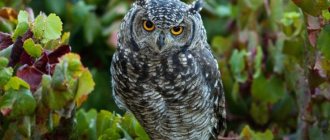There are many varieties of owls in our earthly fauna. The heroine of this story will be a long-eared owl, because it is impossible to pass by such a beauty.
These birds are very amazing and unique creatures. Their way of life continues to arouse genuine interest for many generations of scientists. But these birds always have something new and unusual in their habits for researchers. What secrets does the long-eared owl hide from us?
Long-eared owl (Asio otus).
An owl's brain is smaller than a thimble
Many believe that these birds are extremely intelligent animals. Indeed, they are far from stupid, and are not inferior in intelligence to eagles or, for example, parrots.
Owl - bird of prey
But at the same time, the owl’s brain is tiny and does not exceed the size of an ordinary thimble. This is due to the lack of space in their heads. All free space is occupied by huge eyes, able to notice a small mouse at a great distance even in the darkest time of the day.
What does an owl with ears look like?
Photos of owls adorn many collections and almanacs on European bird species. The long-eared owl has an expressive appearance, thanks to which it has become so popular. The dense plumage is colored brown and ash-gray. Bright white and yellow inserts create patterns that imitate bark. Thanks to its spotted mosaic coloring, the bird hides well in the crown, grass and branches of bushes.
The head is round, straight set. Large golden or orange eyes are the most expressive part of the bird's appearance. The feather is laid out like a fan around the eyes. This creates the impression of flat space. This is necessary to capture sounds and enhance the bird's hearing. There are strongly protruding tufts of feathers on the head. They create imitation ears. But their purpose is also related to hearing and orientation in flight.
Closer photo
The paws are high and densely feathered. At the ends of the fingers there are strong, dark, sharp claws. The long tail creates balance for the body when walking or flying. During summer, the bird creates a characteristic silhouette - a short oval center and wide, rectangular wings with a slight bend.
The sound of an owl: The sound of an owl can be heard at dusk. The bird emits a deep, booming, abrupt cry. It can be described as: "Ooh-oh." Most of all, it resembles the hum of the wind in a clay vessel. In some subspecies, the cry is similar to “wack-wack-wack”. The fledglings produce a “piiii-piiii” sound.
Owl in a pine tree
Owls can swim
Can owls really swim? Although people definitely do not associate these feathered creatures with waterfowl and certainly do not belong to them, owls can swim.
Few people know, but they feel good in the water and, if necessary, are able to swim some distances. Of course, their feathers are not covered with water-repellent protection, and they cannot take off directly from the water: first the birds need to dry out in the sun. But in any case, these birds will not allow themselves to drown.
Interesting! This was proven by one photographer who accidentally captured a swimming owl on his camera. At first it seemed to him that the bird was drowning, but it turned out that it was just floating. The owl made it safely to shore on its own, leaving the photographer in shock.
Swimming owl
Where do owls live
Birds prefer areas that combine forest plantations and open spaces. This is due to its need to search for food and make long flights. Long-eared owls are frequent guests in vacant lots, vegetable gardens, fields and meadows.
Native places of long-eared owls:
- Northern Eurasia;
- North America;
- European part of Russia;
- Western and Central Ukraine;
- Belarus;
- Poland;
- Lithuania, etc.
Owl populations occur in the southern part of the continent from the 63rd to 65th parallel. They choose areas with open spaces interspersed with groves, copses, and gardens. Willingly settles on the outskirts of populated areas, in rural areas. It is not uncommon to find entire families living in summer cottages or in abandoned buildings. Long-eared birds choose places where the terrain is rich in ponds and ditches. Habitats are tied to the food supply.
Photo of a long-eared owl
Female owls are larger and more aggressive than males
This is one of the most interesting facts about owls. Everyone knows from childhood that in the animal world the male is always larger and stronger than the female. But in fact, this belief does not apply to many birds (and especially birds of prey), including owls.
Female owls are larger in size than males. In addition, males are much more passive in their behavior and, in most cases, try to avoid fights.
For example, during the mating season, female white snowy owls fight with other females along with males who defend their right to reproduce among other males.
Females fight for the right to mate with a male
Owls in technology
Owls are known for their silent attack, unlike other birds of prey - falcons or hawks, whose flights are accompanied by a characteristic whistle. The special design of their wings allows them to sneak up on the victim unnoticed. According to researcher Justin Jaworski from Lehigh University in Bethlehem (USA), three main features of owl wings affect their acoustic properties: first, a sharp ridge running along the leading edge of the wing, which, when flapping, slows down the flow of oncoming air, reducing noise; soft down in the front, and finally porous feathers on the trailing edge of the wing, destroying the turbulence that is produced when the air flow shifts behind the wings.
Currently, scientists are looking to apply the information obtained from the study to artificial materials to develop silent vehicles. According to University of Pennsylvania assistant professor Justine Jarowski, learning how to use the owl's noise-canceling mechanism in industrial production could be a huge step forward, especially in the design of aircraft, wind turbines and more. Who knows, perhaps owls will help cope with the main problem of supersonic aircraft - the strong sound wave generated during movement.
Owls are capable of eating prey larger than themselves
Sometimes these predators do not come across any small prey. In such cases, the largest representatives of the owl family, for example, eagle owls, can attack an enemy larger than them.
Cases have been repeatedly witnessed of eagle owls killing foxes, young wild boars, or even a fawn. There have also been cases of eagle owls attacking wolf cubs. Despite the fact that the weight and size of the long-eared eagle owl is much smaller than its prey, such cases occur quite often.
Long-eared owl: description
The long-eared owl (Asio otus) boasts a very ancient origin, since it was already found in the ancient forests of America at the beginning of the Cenozoic era, which is confirmed by the fossil remains of these birds. Despite the fact that many bird species became extinct, they differed little from modern species. The barn owl lived during the Miocene period, and eagle owls have been known since the late Eocene.
Many species of ancient owls had insignificant differences compared to modern species of owls. Firstly, they were not birds of prey, and secondly, their behavior patterns were also different. Only as a result of a centuries-long period of evolution did owls manage to develop their own hunting style. Owls are in shelter and monitor their living space. When a potential victim comes into their field of vision, they attack it, while the owls do not pursue their prey, but accurately calculate the distance for a lightning-fast throw. Today, owls represent a distinct, distinct group of birds, and have been compared to nightjars, rickshaws, and parrots when it comes to defining classes.
In 1758, Carl Linnaeus, a Swedish natural scientist, first described the species "Asio otus". Long-eared owls have a number of distinctive characteristics compared to other owl species. This species has a well-defined facial disc, and on the head you can see “Ears” formed by high tufts of feathers. Narrow and hard feathers covering almost the entire body of the bird have a pleasant “marble” color.
Appearance
It is almost impossible to distinguish males from females. In birds of one sex or another, the head is large and characterized by a round shape. The iris of the eyes is colored yellow or orange. The facial disc is surrounded by dark feathers, the same dark feathers grow around the bird's beak, and the chin is lighter in color. The area of the forehead, enclosed in the space between the ears, is marbled in color.
The eyes are also edged with several rows of black feathers. The ears are formed from three or five feathers, painted in brown tones, and on the outside the feathers have a characteristic reddish tint. The area of the back and neck is painted in similar reddish shades, with the inclusion of brown spots. The spots do not represent the nature of the pattern, and the lower part of the body is characterized by the presence of black stripes, the number of which can be 4 pieces. On the flight feathers, on both sides, you can see 4 brown spots.
Young birds do not have any differences in color compared to adult birds, but their plumage is somewhat softer, and a brown spot can be seen 10 cm from the bend of the wing. Adults grow up to 40 cm in length with a wingspan of almost 1 meter. Males of long-eared owls, compared to females, are characterized by slightly smaller sizes, which is difficult to determine visually.
Owls have long, rounded wings. When a bird sits motionless, the feathers of the wings seem to overlap each other. The bird is armed with a fairly long tail, rounded in shape, consisting of 12 tail feathers. The beak and claws are colored brown. The beak is rounded, but quite sharp, as are the claws, which allows the owl to easily tear its prey into fragments, as well as grab it on the fly. The lower part of the soles is painted gray. Long-eared owls are long-lived, being able to live for about a quarter of a century.
Interesting moment! The owl molts annually, and it changes several plumage patterns. After birth, the plumage of young owls consists of down, after which it changes to mezontil. Only in the second year of life do owls develop real plumage.
Long-eared owl and interesting facts about it - Birds of Russia - Film 14
Where does it live?
Long-eared owls are found on almost all continents, and they can live both on flat expanses and in mountainous areas, at altitudes up to 2 thousand meters above sea level. The main condition is the presence of tall forests, although they can easily settle in bushes. In the mountainous regions of the Tien Shan, this species prefers to spend the winter.
Long-eared owls are migratory species of birds, therefore, in the central regions of our country, these birds appear in March/April. With the onset of autumn cold weather, they go to warm countries for the winter. These birds are found wherever there are green spaces, including thickets of bushes, as well as in park areas of cities. They do not build nests themselves, but they practice settling in abandoned nests of other birds of prey or non-predator.
What does it eat?
The long-eared owl is a typical predator from the world of birds, therefore its diet includes:
- Voles and other small rodents.
- Small birds from the passerine family.
- All kinds of bugs.
- Small animals and rabbits.
- Moles.
- Shrews.
- Stoats.
- The bats.
- Frogs, as well as other types of amphibians.
The basis of their diet depends on living conditions, so in some regions owls mainly feed on rodents, and in other regions on various insects and beetles. In the owl's diet, various birds make up about 10 percent, while various rodents make up about 80 percent. The owl eats its prey completely with bones and feathers, after which it regurgitates the undigested remains of food.
Being in different habitats, owls have developed certain hunting tactics. Living in forest thickets, this predator settles down on a tree branch at a height of 3 to 5 meters and begins to track its prey. An owl attacks it with lightning speed if the victim is at a distance that makes it likely to be caught. When living in open areas and woodlands, owls prefer exploratory hunting while in flight. The bird soars in the air at low speed, examining the surface of the earth with the help of acute vision. The peculiarity of this hunter is that its flight is almost silent, unable to frighten a potential victim, despite the flight altitude, which does not exceed 3 meters.
Behavior and lifestyle
As mentioned above, owls prefer to be nocturnal, and when the sun rises, they hide in dense thickets of vegetation, trying to remain unnoticed. Pairs nest at a distance of about 100 meters from each other. As soon as the nesting period has passed, individuals form flocks, which include several dozen individuals. Such flocks can be found in thickets of vegetation during the daytime. Birds feel safer in the company of their relatives, so they rest peacefully. After sunset, they leave their resting places in search of food, preferring to hunt alone.
Interesting to know! Long-eared owls have as many as 3 pairs of eyelids: one pair is intended for flight mode, protecting the bird’s eyes from dust, as well as from small insects, the second pair is used by the bird when blinking, and the third pair is intended for sleeping.
As a rule, long-eared owls are characterized by a peaceful nature, but during the breeding season, if the bird is disturbed, the owls can become aggressive, protecting their offspring. When you approach the bird, it begins to make hissing sounds and fluffs up its feathers, increasing in size. Basically, these birds are distinguished by their friendly character and, being part of a group, never sort things out among themselves. Since birds can migrate, they do not become attached to their territory and do not try to defend it from other birds.
As a rule, owls prefer to winter in warm countries, flying away for the winter in August/September. Each time they wait out the cold in the same territories, returning to their usual nesting places in March/April, depending on weather conditions.
Reproduction and offspring
In March/April, when owls return from wintering, they begin their breeding season, which is characterized by a special pattern of behavior. Every few seconds they make characteristic sounds in the form of “goo-goo-goo”. With these sounds, partners invite their females, and the sounds are accompanied by frequent flapping of their wings.
Important point! Long-eared owls prefer not to build their nests, occupying homeless nests of crows, magpies and rooks. If there is no suitable nest, the female will easily lay her eggs on the ground among the grass. A nest, no matter whose it is or how comfortable it is, is used by owls only once to breed their young.
The female lays several eggs, but no more than nine, at intervals of several days. The eggs are incubated exclusively by the female, and at night she can leave her nest several times to feed. During the day, the female can turn her eggs about 40 times. Why she does this, scientists do not know. After about 3 and a half weeks, the offspring begin to appear in the order in which the female laid her eggs, so this process can last for several days.
After birth, the chicks weigh about 20 grams, and their body is covered with white down. They cannot see and are practically helpless, but they are capable of making various sounds. On the fourth day of life they begin to see. Despite the fact that the owlets are born several days apart, by the end of the first month of life they all reach the same size and they are all almost similar to their parents, with the exception of the nature of the plumage. By this period, they stop growing, and after another couple of months they develop appropriate plumage.
After birth, the female and male protect and feed their offspring. The female stays close to the chicks all the time, and the male obtains food for his family. During the daytime, you can see the male and female resting near the nest. If you try to get closer to the nest, you can feel the aggressive actions of both the male and the female. After the first month of life, the owlets try to fly from branch to branch and from tree to tree. At the same time, they still do not have the skills to obtain food, so their parents are in charge of feeding them. Despite this, at 2 and a half months, the chicks still leave the nest, even if they cannot fly. When the offspring reach one year of age, they can reproduce.
Natural enemies of long-eared owls
Adult owls have practically no natural enemies, although they can become prey for larger birds of prey, such as hawks or falcons, and then only in the daytime due to their carelessness. Long-eared owls are often hunted by eagle owls and owls. Otherwise, the life of these predators passes quietly, especially during the non-nesting period, when they try to stick to small groups. Martens and stoats destroy the nests of these birds. In addition, if owls live not far from a person, a domestic cat can climb into their nest, but this happens very rarely, since few pets are eager to hunt naturally. Therefore, the most susceptible to attack are young, inexperienced birds, as well as defenseless chicks. Some birds do not survive during flights to wintering grounds, as well as back to their habitats.
The diseases to which owls are susceptible are parasitic in nature.
The following types of mites can live in the nasal cavity of owls:
- bricinboricus Btc.
- Sternastoma strigitis Btk.
- Rhinoecius oti Cooreman.
Fleas of the species “Ceratophillus gallinae”, as well as other parasitic insects, are found on owls. The number of long-eared owls depends on the availability of green spaces, as well as on the nature of the ecological situation in their habitats. There are hungry years when parents are unable to feed their offspring and the owlets die. In years when food supply is favorable, the total number of owls increases, as parents manage to feed all their offspring.
Owls are forest nurses
Farmers often install special boxes on their farms for these nocturnal predators to nest there. This is how people fight rodent infestations.
Short-eared owls, which feed exclusively on rodents, can be especially useful on the farm.
Interesting! Just one individual is capable of catching about 8 hundred mice in a month.
Owl hunting
What does it eat and how does it hunt?
Small rodents: voles, shrews, mice are the main food of long-eared owls. Even when the bird is not hungry, when it sees a rodent, it will grab the victim. Birds catch mice for future use, especially if a couple has chicks.
Note! By eating harmful rodents, long-eared owls bring great benefit from the mouse scourge.
Birds of prey do not disdain small birds and insects. The menu is varied:
- beetles (Khrushchev, May beetles, mole crickets);
- moles, rats;
- the bats;
- squirrels, hares;
- frogs, toads;
- lizards, snakes.
There are known cases of attacks by long-eared owls on large birds: partridges, rooks. The diet of predators depends on their habitat. A long-eared owl hunts while sitting on a tree branch if it lives in the forest. Tracks down the victim and instantly rushes at it. In rainy weather, the bird patiently watches for prey, sitting on the ground.
If, in search of food, a bird smoothly soars over a field, seeing prey, it throws a stone down, although owls fly no higher than 3 meters above the ground
The tassels on an owl's head are not ears
Some owl species are distinguished by the presence of peculiar ears on their heads. And many people are sure that these are real ears.
They're actually just feathers. They were not invented for beauty, but also perform an important function - they convey the emotions of the bird. By the position of these ears, you can recognize fear, joy, or an aggressive mood in a bird. Real ears are hidden in the head and often one ear is larger than the other.
Great Eared Eagle Owl
Owl: hunting features
Owls and eagle owls are not the only birds that forage for food at night. Ducks, nightjars, and some waders hunt at night, and each of these birds has a unique mechanism that allows them to find prey in the dark, relying not only on vision. Ducks, for example, benefit from their sense of smell, and owls benefit from acute hearing. In fact, if this bird relied mostly on sight when hunting, it would often remain hungry - for example, on moonless or cloudy nights. After all, no one can see in absolute darkness, not even an owl.
Excellent hearing
Their extraordinary hearing helps these birds hunt. Interestingly, this feature highly exalts them above other birds who can only dream of such exceptional hearing.
Owl ears even have something similar to auricles. Any purity, the highest and the lowest, can never escape the owl. In addition, their ears determine with amazing accuracy the location from which a particular sound is coming. This ability leaves the rodent almost no chance to hide even deep in a hole.
Paper owl craft
For the craft we will need:
- Colored paper;
- White cardboard;
- Glue;
- Scissors;
- Pencil or felt-tip pen.
Glue the ears with the point up, the beak with the point down. Next, cut out eye blanks from white paper: 2 ovals 2 cm wide and 3 cm long. Glue the eyes. Cut out 2 smaller ovals from black paper. We glue the pupils. Now you need to draw, cut and glue the wings on the sides. The owl is ready.
Have unusual eyes
We can also talk about owl eyes for a very long time, as they amaze with their originality. They are designed completely differently from those of humans and most animals.
- No eyeballs
This sounds incredible, but owl eyes actually lack eyeballs, and the organs of vision themselves are some kind of tubes that stretch from the very back of the head.
Thanks to such a complex optical mechanism, owls are able to see the world around them, as if through a microscope. One can only imagine what amazing hunting ability this feathered species has, if they have such keen vision and unsurpassed hearing in their arsenal.
- Having three pairs of eyelids
The second interesting feature of owl eyes is the presence of three pairs of eyelids. Moreover, each has its own function: the first takes care of the health and cleanliness of the eyes, the second takes care of blinking, the third protects the eyes during sleep.
Due to the unusual structure of their eyes, these predators do not have the ability to move their pupils: in order to see what is out of sight, they have to turn their heads. Therefore, nature has endowed them with extreme flexibility to rotate their heads 270°.
Differences in the owl's hearing organ
The owl's hearing organ is unique. No other bird has a similar device. With the help of skin folds around the owl's auditory opening, a semblance of an auricle is formed, and feathers growing in a special way create something like a mouthpiece. Moreover, there are tufts of feathers resembling ears, for which one of the species of owls was nicknamed “long-eared”. This has nothing to do with it. Hearing is enhanced by the feathers that surround the owl’s “facial disc.” Thanks to the peculiarities of the arrangement of these feathers, the owl can better hear the sounds that are heard behind it. But this does not pose any inconvenience to her, since the owl is capable of turning its head almost 180 degrees.
Another feature of an owl’s “ears” is their asymmetry. The axes of the auditory openings can be located at different angles and diverge in different directions, which allows the owl to more accurately detect the location of the sound source. It is for this reason that owls so funny tilt their heads to one side, turning them at different angles.
In addition, the owl's acute hearing is ensured by an enlarged eardrum, the area of which is approximately 50 square millimeters. In chicken, for example, it is half as much. The owl's eardrum also has a tent-shaped bulge, which further enhances its sensitivity. But the external structure of the hearing organs is not all that makes the owl an ideal night hunter, because even its auditory nerves are much more complex and better developed than those of other birds.
So the well-known metaphor “deaf as a tererev” can be contrasted with the phrase “hears like an owl.” But you shouldn’t envy owls in this regard: such acute hearing could cause inconvenience to a person. For people to have a successful and fulfilling life, they don’t necessarily need to hear mice running around in the snow!
They belong to one of the most ancient orders of birds.
Owls are an exceptionally ancient species of birds. Interestingly, the first fossil species of this predator appeared long before our era, and was called “ornimegalonyx”. The familiar owl has also been known to man for a very long time:
- owl figurines were found in Greece in the 7th century. BC.;
- mentions of these birds are contained in the works of Virgil and Ovid;
- Aristotle in his works described two types of owls.
Owl figurine. Greece. 640 BC
From the cones
A cedar or fir cone is suitable for the body. The head can be replaced by any other smaller cone. Use glue for fastening. If a child is helping you, it is better to take plasticine.
- Connect your head and torso at an angle towards each other. In principle, you can use one large cone.
- Make paws from dry branches or two bean pods.
- For the wings, create small holes on the sides of the pine cone by removing a few scales. Now coat the resulting voids with glue and fill with branches. Pieces of dried orange or tangerine peel will look unusual as wings.
- Eyes can be made as described above. Here's another option. Two small bundles of hay or straw are tied with threads in the middle. Then two buttons are strung on them. The ends need to be fluffed. Carefully make two holes in the cone and pass the prepared blanks through them. We got cute eyes with eyelashes.
- You already know how to make a nose and ears.
- You can put moss at the base. Attach another piece to the head. The funny creature is ready.
- If you put a string on top, the figurine can be hung as a Christmas tree decoration. An owl craft made from pine cones looks just right in the atmosphere of the winter holidays.
Not very suitable for indoor use
Despite the fact that some bird lovers keep owls in their homes, and it is believed that these birds live longer in captivity, having such a predator as your favorite is not the best idea.
The main reason for this is their nocturnal lifestyle, which is practically incompatible with the human regime. At night, these birds begin to “disco” and nothing can be done about it.
Add to this their nightly cries and a special menu in the form of live rodents - this combination can completely discourage even the most avid bird lover from having an owl.
Owlet in captivity
Interesting facts about the bird
- The bird's wing provides ideal aerodynamics in flight. The muscular system allows the wing to be moved to a semi-vertical position to change low-level flight into a dive.
- The bird hears the rodent from a distance of 5-9 m.
- A bird's vision allows it to navigate well in a forest or field. Additional means of orientation are feathers of “ears” and masks. They pick up air vibrations and sounds, sending signals to the owl.
- The long-eared owl has the most versatile information processing apparatus. The lobes of the brain responsible for this are clearly expressed. It can distinguish and analyze 1000 signals.
- Until the 17th century, the symbol of the owl in Christianity was associated with dark magic. And only later, thanks to the Age of Enlightenment, it began to mean science, wisdom and knowledge.
- In Ancient Egypt, the owl was considered a messenger of the gods. She was revered and even mummified. The owl symbol entered the Egyptian alphabet.
- The owl uses its call to communicate or call a partner. The rest of the time she is silent.
- The owl does not build its own nest, so it willingly takes away the homes of crows and magpies.
- The chicks do not leave the nest immediately. They gradually move to neighboring branches. Up to 3 months of age, adult birds feed their offspring, preparing them for adulthood.
Long-eared owl in a pellet
Listen to the voice of the long-eared owl
The audio tag is not supported by your browser. Close
Not all owls hoot
Not everyone knows this, but the famous owl hoot accompanies not all representatives of the owl family.
Some species make completely different sounds: some squeak, others hiss, others growl, and in others the sound generally resembles the barking of a dog. Barn owls, for example, make sounds somewhat reminiscent of a hoarse “heh,” from which they get their Russian name.
For reference! Females are usually much more talkative than males, especially during the mating season. The screams are often very loud and can be heard for many kilometers around.
Features of behavior and lifestyle
Long-eared birds are nocturnal. They sleep during the day, and at dusk they go hunting:
- Because of their nocturnal lifestyle, owls are attributed magical qualities and are treated with caution. But nocturnal activity has nothing to do with the other world (as many believe), but is just one of the features of the life of the long-eared owl. It is convenient for birds to hunt when it is dark.
- Birds live in small flocks. When birds nest, they settle at a distance of no more than 120 m from each other. Being nearby makes it easier for long-eared predators to defend themselves from enemies.
- During the day, they fly to the tops of spruces, pines or tall bushes, where they calmly rest and gain strength. When the sun sets below the horizon, long-eared predators fly out to hunt, and they hunt not in packs, but alone.
- They do not attack people, but they do not feel fear of a person. If a stranger dares to come close, the owl may show belligerence: it fluffs up its feathers and hisses menacingly, as if warning that it might bite.
Predators get along with each other and live peacefully. If strangers do not bother the long-eared birds, then the birds do not mark their territory. After all, they do not build their own nests, but occupy those left by other birds.
Note! Long-eared owls always spend the winter in the same place, where they flock in the fall. Birds return from wintering, like rooks, in April.
What does an owl like?
Owls are very sociable and love to play. Owls' favorite toys can be: fur toys made for cats (various mice), small ringing objects (for example, a bell), various rags, woolen socks and other “furry” objects.
Interesting materials:
How to paste copied text in Word? How to insert a link to an external site into VK text? How to insert a table into the body of an email? How to paste text on a laptop without a mouse? How to insert text under text in Word? How to insert text from Word into a compass? How to insert text at the top of a table in Word? How to insert text into a shape in Excel? How to insert text into a shape in a presentation? How to insert text into a shape in Word 2016?











